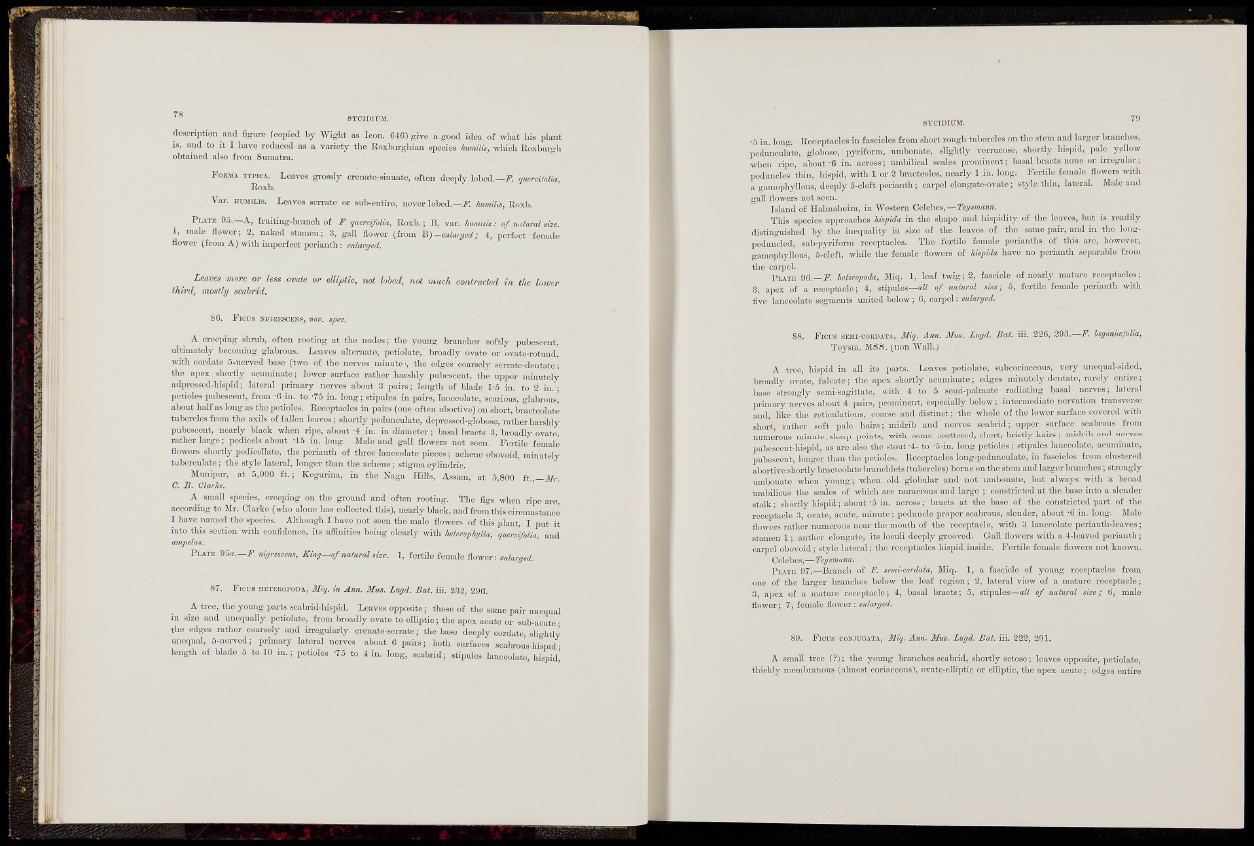
description and figiu-c feo]>ietl by Wight as Icon. 646) give a good idefi of wliat Iiis plant
is, aud to it I have reduced as a variety the Roxburgliiaa spocics humili», which Roxbiu-iih
obtained also from Smnati-a.
FORMA TYPICA. Leaves gi-ossly crenate-siiiuate, often deci)LY lobcd.—IL (juerdtoUa,
Rosb.
Var. HUMILIS. Leaves serrate or sub-entire, never l o b e d .—h imUs , Roxb.
PLATE 95.—A, fruiting-branch of F. querdfolia, Roxb.; B, var. humiiis: of natural size.
1, male flower; 2, naked stamen; 3, gall flower (fi-om B)-enlu,ged; 4, pcrfect female
flower (from A) with imporfect perianth : enlarc/ed.
Leaves more or less ovate or elliptic, not hhed, not much contracted in the hm
third, mostly scabrid.
86. FICUS NIGRESCENS, VOV. SpeC.
A creeping shnib, often rooting at the nodes; the young branches softly pubescent,
ultimately becommg glabrous. Leaves alternate, petiolate, broadly ovate or ovate-rotund,
with cordate o-nerved base (two of the nerves minute, the edges coarsely sen-ate-dentate •
the apex shortly acuminate; lower sm-face ratlier harslily pubescent, the ujjper minutely
adpressed-hispid; lateral primary nei-ves about 3 pairs; length of blade I-o in. to 2 in.';
petioles pubescent, from -6 in. to -75 in. long; stipules in paii-s, lanceolate, scarious, glabrous^
about half as long as the petioles. Receptacles in pairs (one often abortive) on short, bracteolate
tubercles from the axils of fallen leaves; shortly peduneulatc, depres.sed-globoso, rather harshly
pubescent, nearly black when ripe, aljout -4 in. in cHameter; basal bracts 8, broadly o\'atc,
rather large; pedicels about -15 in. long, Male and gall flowers not seen. Fertile female
flowers shortly pedicellate, the perianth of tlu-oe lanceolate pieces; achene obovoid, minutely
tuberculate; the style lateral, longer than the acheno; stigma cylindric.
Munipur, at 5,000 ft.; Kegurina, in the Naga Hills, Assam, at 5 800 ft — Mr
C. B. Clarlu.
A small species, creeping on the gi-ound and often rooting. The figs when ripe are,
according to Mr. Clarke (who alone has coUected thisj, nearly black, and from this circum,stance
I have named the species. Although I have not seen the male flowers of this plant, I put it
into tliis section with confidence, its affinities being clearly with hetcrophi/lla, quercifoUa and
slas. '
PLATE 95a.~F. nigrcscem, King^of naiural nze. 1, fertile female flower: mlarged.
87. FIC'L'S HETEROPODI, Miq. in Ann. Mas. Ltigd. Bat. in. 232, 296.
A tree, the young parts scabrid-hispid. Leaves opposite; those of the same pair unequal
in size and unequally petiolate, from broadly ovate to elliptic; the apex acute or sub-acutethe
edges rather coarsely and irregularly crenate-serrate; tiie base deeply corciate sli"-htlv
unequal, 5-nerved; primary lateral nerves about 6 paii-s; both surfaces scabroJs-hispid•
length of blade 5 to 10 in.; petioles -75 to 4 in. long, scabrid; stipules lanceolate, hispid'
•5 in. long. Receptacles in fascicles from short rough tuberclcs on the stem and larger branches,
pedunculate, globose, pyi-iform, iimbonate, slightly verrucose, shortly hispid, pale yellow
when ripe, about -6 in. across; umbilical scales prominent; basal bracts none or irregular;
])edunclcs thin, hispid, with 1 or 2 bracteoles, nearly 1 in. long. Fertile female flowers with
a gamophjdlous, deeply 5-cleft perianth; carpel elongate-ovate; style thin, lateral. Male and
gall flowers not seen.
Island of Ilalmaheira, in Western Celebes,~Tei/smann.
This species approaches hispida in the shape and hispidity of the leaves, but is readily
distinguished by the inequaHty in size of the leaves of tlie same pair, and in the longpeduncled,
sub-p}Tifor)n receptacles. The fertile female perianths of this are, liowever,
gamojjhyllous, 5.cleft, wlnle the female flowers of luspida have no perianth separable from
the carpel.
PLATE 96.—J'- heteropoda, Miq. 1, leaf twig; 2, fascicle of nearly mature receptacles;
3, apex of a receptacle; 4, stipules—a« of natural size; 5, fertile female perianth with
five lanceolate segments united below ; 6, carpel: enlarged.
88. Ficus SEMI-CORDATA, Miq. Ann. Mus. Luyd. Bat. iii. 226, 293.—Z Ugonicefolia,
Teysm. MSS. (non Wall.)
A tree, hispid in all its parts. Leaves petiolate, subcoriaceous, very unequal-sided,
broadly ovate, falcate; the apex shortly acmninate; edges minutely dentate, rarely entire;
base strongly semi-sagittate, with 4 to 5 semi-palmate radiating basal nerves; lateral
primary nerves about 4 paii-s, prominent, especially below; intermediate nervation transverse
and, like the reticulations, coarse and distinct; the whole of the lower surface covered witli
short, rather soft pale hairs; midrib and nerves scabrid; upper sm-face scabrous from
numerous minute. sharp points, with some scattered, short, bristly hairs ; midrib and nerves
pubescent-hispid, as ai-e also the stout -4- to -o-in. long petioles ; stipules lanceolate, acuminate,
pubcscent, longer than the peiioles. Receptacles long-pedimculate, in fascicles from clustered
abortive shortly bracteolate branchlets (tubercles) bnrne on the stem and larger branches; strongly
umbonate when young; when old globular and not mnbonate, but always with a broad
umbilicus the scales of which are numerous and large ; consti-icted at the base into a slender
stalk; shortty hispid; about-5 in. across; bracts at the base of the constricted part of the
receptacle 3, ovate, acute, minute; peduncle proper scabrous, slender, about -6 in. long. Male
flowers rather numerous near the mouth of the receptacle, with 3 lanceolate perianth-leaves;
stamen 1; anther elongate, its loculi deeply grooved. Gall flowers with a 4-leaved perianth ;
cai-pel obovoid; style lateral; the receptacles liispid inside. Fertile female flowers not kno-wn.
Celebes,—re^/sw"««-
PLATE 97.—Branch of F. semi-cordata, Miq. 1, a fascicle of young receptacles from
one of the larger branches below the leaf region; 2, lateral view of a mature receptacle;
3. apex of a mature receptacle; 4, basal bracts; 5, stipules—all of natural size; 6, male
flower; 7, female flower : enlarged.
80. Ficus coNJUGATA, Miq. Ann. Mus. Lugd. Bat. iii. 222, 291.
A small tree (?); the young branches scabrid, shortly setose; leaves opposite, petiolate,
thickly membranous (almost eoj-iaeeous), ovate-elliptic or elliptic, the apex acute; edges entire